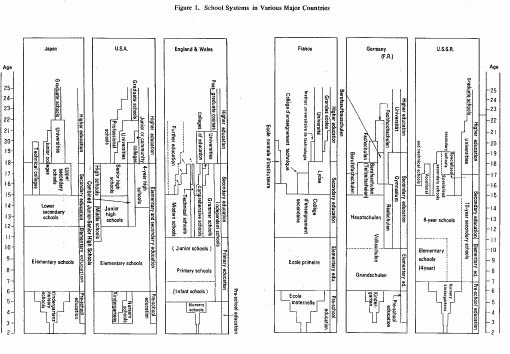| Home > Policy > White Paper, Notice, Announcement > White Paper > EDUCATIONAL STANDARDS IN JAPAN 1971 > CHAPTER |
||
After World War ![]() , schools shifted to a 6-3-3-4 "single-track" system,
in order to equalize educational opportunities. Under this new system, we have
attained, during the quarter of a century since the end of the war, a high status
among the advanced countries of the world in terms of educational expansion.
In recent years, however, the necessity for reappraising the existing system
has been increasingly voiced with the aim of realizing the basic ideal of equal
educational opportunities as well as meeting the requirements of a modern industrial
society. One of the biggest problems has been providing educational institutions,
which can meet the diverse abilities and aptitudes of those who are going on
to upper secondary educational institutions in increasing numbers every year.
In light of this, technical colleges were established in 1962 to provide lower
secondary school graduates with five consecutive years of technical education.
Moreover, there has recently been a need to reappraise the structure of the school
system from the point of pupils' development.
, schools shifted to a 6-3-3-4 "single-track" system,
in order to equalize educational opportunities. Under this new system, we have
attained, during the quarter of a century since the end of the war, a high status
among the advanced countries of the world in terms of educational expansion.
In recent years, however, the necessity for reappraising the existing system
has been increasingly voiced with the aim of realizing the basic ideal of equal
educational opportunities as well as meeting the requirements of a modern industrial
society. One of the biggest problems has been providing educational institutions,
which can meet the diverse abilities and aptitudes of those who are going on
to upper secondary educational institutions in increasing numbers every year.
In light of this, technical colleges were established in 1962 to provide lower
secondary school graduates with five consecutive years of technical education.
Moreover, there has recently been a need to reappraise the structure of the school
system from the point of pupils' development.
In the United States of America, a single-track system has been practiced since the latter half of the nineteenth century. The structure of elementary and secondary schools, however, differs front one community to another. There are 8-4plans. 6-6 plans and 6-3-3 plans. In recent years, such new practices as 5-3-4 plans and 4-4-4 plans have been developed to adjust the school structure more adequately to the development of pupils. Higher education is usually provided by four-year universities and two-year junior colleges. Recently, two-year junior or community colleges have been increasing, especially for the purpose of providing secondary school graduates with wider opportunities for higher education. Junior colleges have traditionally functioned as both lower stage institutions of higher education and institutions of vocational education. In recent years, however, with the increasing proportion of those going on to higher educational institutions, vocational education suited to the needs of communities has been stressed.
In European countries, school systems developed on the "multi-track" basis. After completing elementary education, pupils have been divided into two groups, those who go on to instituti6rns of higher education and those who go on to vocational schools or enter employment. Recently, however, there has been a marked movement toward the "sing1e-track" system and so barriers between different types of schools at the secondary level are being increasingly removed.
In England and Wales the abolition of eleven-plus examinations and the reorganization of secondary schools into comprehensive schools have been attempted in some parts of the country since 1965 so as to defer the time for dividing pupils into college preparatory and vocational courses until the stage of upper secondary education.
In France, deferring the time of diversifying courses until the upper secondary education stage has been attempted since 1964 by reorganizing the lower secondary stage into comprehensive schools which offer the same curriculum to all pupils.
The Federal Republic of Germany is also making efforts to defer the time of diversification by introducing observation periods into the lower stage of secondary education, which had previously been diversified.
The school structure of the U.S.S.R. is based on a single-track system. Unlike European countries, however, there are three different patterns according to the characteristics of the locality: in rural areas, 4-year schools form the basis of the school system, while in urban areas, the bases are either 8-year or 10-year schools. At the upper secondary stage, pupils enter either of two types of institutions,i.e.. educational institutions mainly designed for those who want to go on to universities(ninth and tenth grades of the ten-year School) and vocational educational institutions of a terminal nature (specialized secondary schools. and vocational and technical schools). In recent years, attempts have been made toward diversifying the former.
The foregoing analysis shows that in those countries in which single-track systems have been in force, such as Japan, the U.S.A. and the U.S.S.R., there is a tendency toward diversifying education beyond the lower secondary stage, while in European countries where multi-track systems were developed; the tendency is toward single-track systems.
As a result of the expansion of upper secondary education, however, the expansion of opportunities for higher education has become a great problem. This has led all these countries to take measures to reform their systems of higher education or to expand their accommodation capacities.

| Back to Top | MEXT HOME |